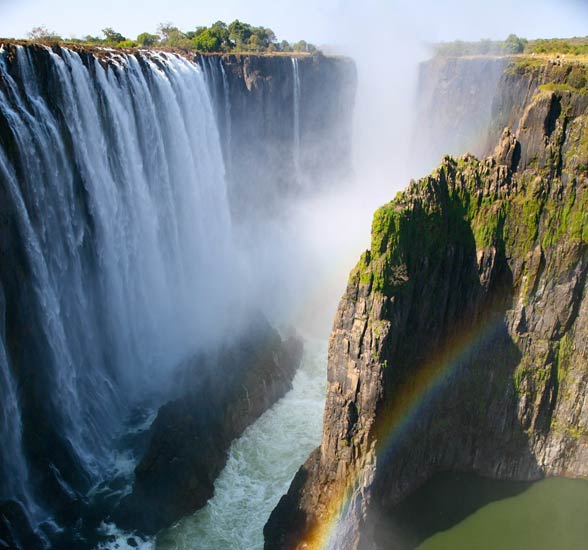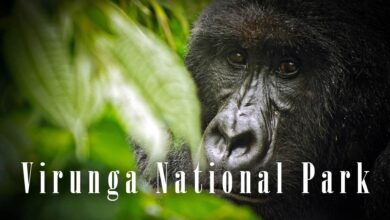Victoria Falls
Victoria Falls (Mosi-oa-Tunya, “The Smoke that Thunders”)
Victoria means “victory”. The symbol of the victory of nature over human capabilities could become the Victoria Falls. This victory consists of their size, but not only. Perhaps because of this greatness, the European explorer gave them a name in honor of the great British Queen? We invite you on a spiritual journey to distant African countries, to feel the power of a great cascade at least for a moment.
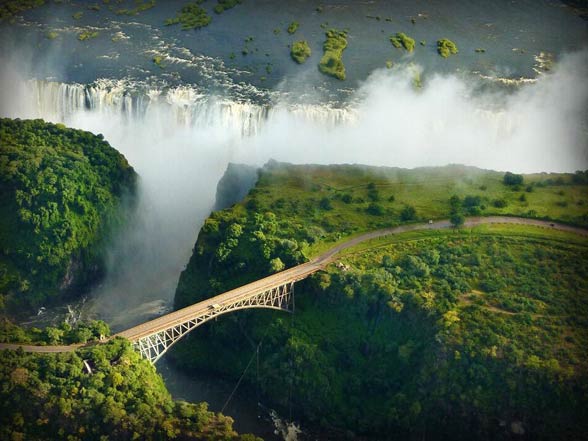
Location
Located in the south of Africa, Victoria’s waterfalls function as a natural border between two countries: Zimbabwe and Zambia.
Waterfalls are located on the Zambezi River – the fourth longest river in Africa.
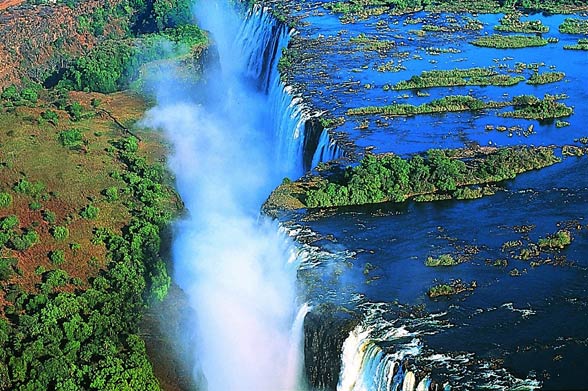
“The Smoke That Thunders” vs. Queen Victoria
David Livingstone’s Scottish traveler and missionary is considered to be the first European to admire the beauty of the Victoria Falls. In November 1855 Livingstone found itself on one of the two land masses in the middle of the Zambezi River, almost on the edge of a waterfall. Today, this large strip of land is called Livingstone Island (let us not confuse it with Livingston Island, which is located in the Antarctic region).
The Scot described above is responsible for the European name of the waterfalls. Livingstone gave it in honor of the British Queen Victoria, ruling in the nineteenth century. This name did not have much in common (or rather had nothing to do …) with the term used by local inhabitants of Africa, and it sounded Mosi-oa-Tunya, which can be translated as “Smoke that thunders” or – more correctly – “Mist that thunders.” The same name is given to the nearby national park in Zambia. Victoria Falls is the name of the national park in Zimbabwe and one of the cities there.
The local name of the waterfall refers to the mist that constantly floats under the waterfall. This is the result of drops of water rising into the air. From a distance, this haze looks like clouds, among which rainbows appear (even at night, in the light of the Moon).
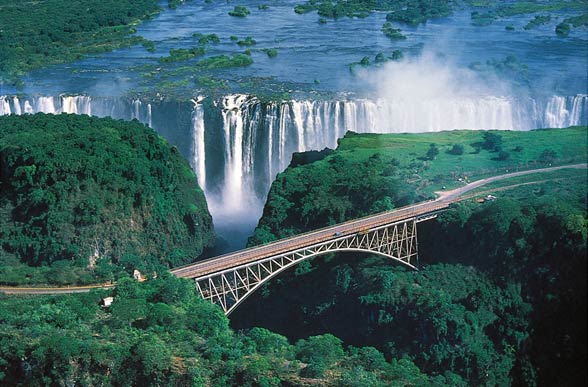
Dimensions – (not) the largest waterfall in the world
Certainly, the Victoria Waterfall is incredibly impressive and the frighteningly bang of the water falling from high causes an adrenaline rush. In terms of height and width, however, this is not the largest waterfall in the world. It is only after the connection of the height (108 m) with the width (1708 m) that we get the world’s largest sheet of falling water.
It should be noted that the Victoria Falls are two times higher than the North American Niagara Falls (51 m) and more than twice as wide. Anyway, we are dealing with a real water giant, which in terms of the amount of water flowing in a second (1088 m3 / s) is ranks 7th in the world (Niagara is in place 5th with a flow of 2407 m3 / s).
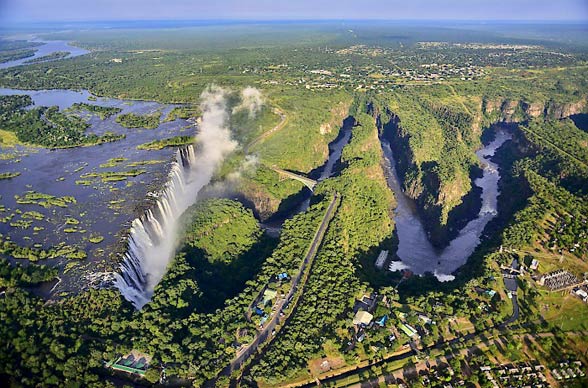
Rise
The Victoria waterfall was created about 150 million years ago due to the earth’s tectonic movements.
Before the water from the river reaches the waterfall, it flows slowly through a wide, branched riverbed. Then it falls with a bang along the cliff to get to the narrow, zigzag ravine. Satellite images clearly show that the riverbed under the waterfall looks like a crack. Both the cliff forming the waterfall and the lower riverbed are “relic” after the movements of tectonic plates.
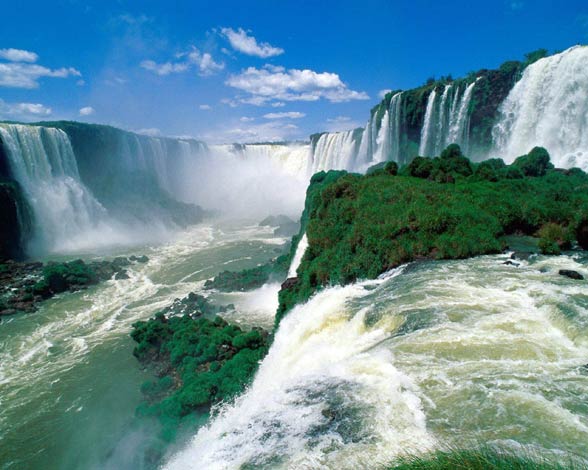
Main attractions
Probably the most famous place in the Victoria Falls is the so-called Devil’s Pool. This object is nothing but the effect of thousands of years of rock erosion. There are many similar pools, but the Devil’s Poll has a certain, electrifying property – it is located on the edge of a waterfall.
Interestingly, tourists can enter this pool (and many of them do so). This is possible between September and December (or from mid-August to January), i.e. during the dry season. During this period, the water is stable and the currents are weak, which is why visitors to Victoria Falls can bathe in relatively safe conditions.
There were, of course, fatal accidents, but it was rather the result of irresponsibility – some adventurers came out of the pool, crossing the safe rock threshold and stood at the very edge of the cliff. In this way, it is not difficult to find a tragedy.
To enter the Devil’s Pool, you should hire a guide – usually a native – who will show you where you can safely sit and what you cannot do.

National parks
Two national parks have been created within Victoria Falls: the Mosi-oa-Tunya National Park in Zambia and the Victoria Falls National Park in Zimbabwe. The first one has an area of 66 km2, the second only 23 km2.
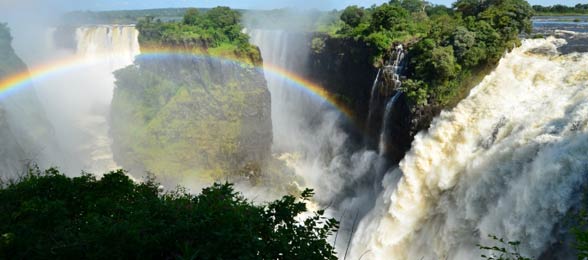
Animals (fauna)
In both national parks, many species of animals live, including: antelopes, zebras, elephants, buffaloes and giraffes. Seldom can be found lions from the south-eastern subspecies, Namibian cheetahs and leopards. There are common baboons and Chlorocebus. The river region above the waterfall is a home for crocodiles and hippos. The lower part of Zambezi is rich in 39 species of fish and the upper part in 89.
The national parks are home to African clawless otter (Aonyx capensis), ratel, klipspringer (Oreotragus oreotragus) and lizards. There are 35 species of birds of prey, such as the Verreaux’s eagle (Aquila verreauxii), peregrine falcon (Falco peregrinus) and Taita falcon (Falco fasciinucha), jackal buzzard (Buteo rufofuscus) and white-tailed eagle (Haliaeetus albicilla). We also meet numerous representatives of waterfowl.

Plants (flora)
In the local area, the Fabales (Colophospermum mopane) as well as savanna vegetation dominate. The real “gem” is the rainforest, nurtured by water splashing from the waterfall. The extraordinary forest includes, among others Afzelias, Diospyros, palms of the genus Phytelephas, Wild date palms. You cannot forget about the countless climbing plant and lianas.
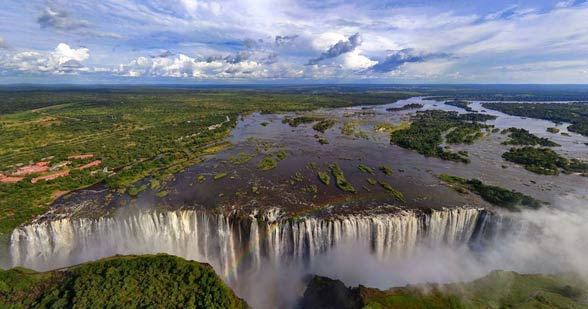
Detailed data / dimensions
Victoria Falls
- Height: 108 m (355 ft)
- Width: 1,708 m (5,604 ft)
- Average flow: 1 088 m3 / s (1 088 000 liters / s) / (38,430 cu ft/s)
- Flow in the rainy season: up to 12,800 m3 / s (12,000,000 liters / s) / (452,000 cu ft/s)
- Records: the largest sheet of falling water in the world
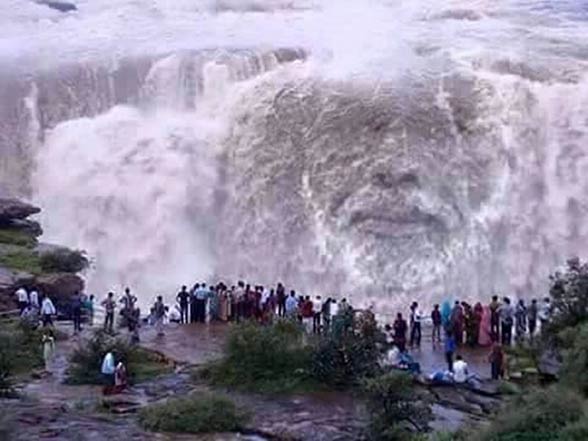
Victoria Falls – interesting facts
- During the rainy season up to 12,000,000 liters of water flows from the waterfall every second.
- The fog over the waterfall can be seen from a distance of 20 km in the dry season and about 60 km in the rainy season.
- The sound of falling water is heard from a distance of about 40 km.
- The authorities of Zimbabwe and Zambia allow tourists to visit the Waterfall regions. However, to be able to do so, you need to buy a visa. The cost of the document ranges from 45 to 80 dollars. However, visa regulations are very often changed, so tourists going to those areas should regularly monitor the regulations.
- Below the Waterfall, in one of the six gorges, a bridge was built crossing the Zambezi River. It is called Victoria Falls Bridge and connects two countries. Border guards stand at both ends of the bridge. The total length of the bridge is 198 m and is located at an altitude of 128 m. It is also one of the places where you can perform bungee jumping.
